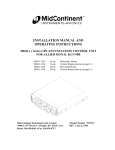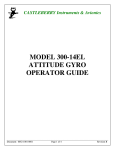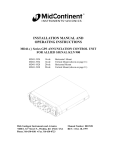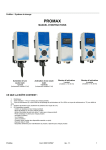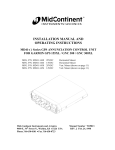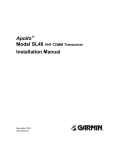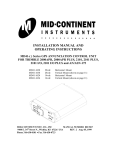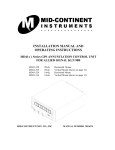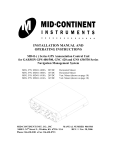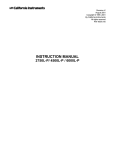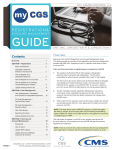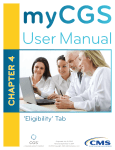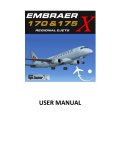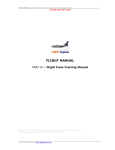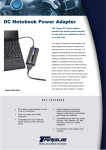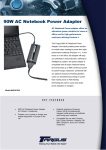Download AC91-5 - Civil Aviation Authority of New Zealand
Transcript
Advisory Circular Subject: 1. Operation of Portable Electronic Devices (PEDs) During Flight Under IFR GENERAL. Civil Aviation Authority Advisory Circulars (AC) contain information about standards, practices and procedures that the Authority has found to be acceptable for compliance with the associated rule. Date: In the attached procedures the use of the imperative, shall and must, terms not normally welcome in an AC, is because it is a direct copy of the mandatory provisions of the RTCA document. AC91-5 Author: Chris Lamain Each reference to a number in this AC, such as 91.15, is a reference to a specific rule within Part 91. 2. PURPOSE. This AC provides methods acceptable to the Authority for showing compliance with the requirements for the operation of portable electronic devices during flight under IFR. 3. CANCELLATION. There was no previous issue, so there is no cancellation. 4. FOCUS. This material is intended for the operator and the pilot-in-command of an aircraft operating under IFR. 5. RELATED CAR. This AC relates specifically to CAR 91.7, Portable electronic devices. Consideration will be given to other methods of compliance which may be presented to the Authority. When new standards, practices or procedures are found to be acceptable they will be added to the appropriate AC. 1 April 1997 Published by Civil Aviation Authority PO Box 31441 Lower Hutt ISBN 0-478-06985-5 ©New Zealand Government Printed by: Use of Portable Electronic Devices During Flight Introduction The possibility of portable electronic devices interfering with the operation of aircraft systems has been a topic of interest and inquiry for some time. The discovery of the transistor and its development through the 1950’s led to the creation of a large number of portable electronic devices (PEDs) for the consumer market. Broadcast radio receivers, tape recorders, computers, cellphones, tape recorders and electronic games are but a few of the many devices that came into popular use due to the minitiarusation of electronic components afforded by the transistor. Inevitably PEDs were carried and used by aircraft passengers in flight. Initially, because the electromagnetic radiation characteristic of these devices was largely unknown, there was little reason to restrict their use in aircraft. As the use of PEDs came into popular use on board aircraft the then US Civil Aeronautics Authority asked the Radio Technical Committee for Aeronautics (RTCA) were asked to investigate the potential interference effects from PEDs. Subsequently they released their report, Potential Interference to Aircraft Electronic Equipment from Devices Carried Aboard [DO-199, 1988) and made extensive recommendations for alleviating problems associated with PED interference. These recommendations are the basis for the requirements in rule 91.7, Portable electronic devices. PEDs do cause interference with aircraft systems, with a number of reported incidents potentially hazardous to the safety of the aircraft. Verifying the interference and identifying the mechanisms which cause interference is being further researched by the RTCA. Use of Portable Electronic Devices During Flight Table of Contents i AC91–5 1. Rule objective 1.1 The Authority has received a number of reports on incidents resulting from interference on aircraft systems by PEDs. These reports, from New Zealand operators and foreign agencies, indicate that PEDs may affect communication, navigation, auto-pilot, autothrottle and air-conditioning systems. Some of the effects have resulted in large, and sometimes rapid, deviations of the aircraft from the intended flight path. 1.2 The objective of the 91.7 requirements is to limit any possible interference to portions of flight when systems are operating which will alert the flight crew to a possible PED-induced deviation which may result in the aircraft deviating from the intended flight path. 1.3 The rule– (a) lists PEDs that may be used at any time during the flight; (b) restricts the use of PEDs during the take-off and approach phases of flight; (c) allows the use of PEDs during the cruise when TCAS or TCAD is operating; and (d) allows the use of a PED during the cruise when the individual PED has been certified as being suitable for use on an aircraft. 2. Abbreviations EMI is electromagnetic interference: (i) the restriction on the operation of any PED during take-off to initial top-of-climb and from final top-ofdescent to landing; and (ii) permissible times, conditions, and limitations when specific PEDs may be used; and (b) the procedures for inter-operation between flight crew, and for the coordination between the flight crew and the cabin crews for monitoring of possible PED interference; and (c) the procedure(s), in accordance with 91.5(c), to terminate the operation of a PED suspected of causing interference with an aircraft system; and (d) the procedure(s) for reporting instances of suspected and confirmed interference by a PED as required under Part 12; and (e) the procedure(s) for certifying the suitability of PEDs to be operated onboard the aircraft in accordance with 91.7(c)(3) (refer Section 3); and (f) the procedure(s) for verifying that PEDs used on-board the aircraft in accordance with 91.7(c)(3) have been certified as acceptable for use on-board the particular aircraft. 4. Recommended procedure for certifying PEDs for use on aircraft PED is a portable electronic device: RTCA is the Radio Technical Committee for Aeronautics: TCAD means traffic alert avoidance device: and collision TCAS means traffic alert avoidance system. and collision 3. Recommended procedures for the use of PEDs If you allow the use of PEDs onboard your aircraft, you should establish procedures to control and limit their use during IFR flight in accordance with 91.7(c). The procedures should establish at least the following– 2 (a) the method(s) to inform passengers, as required under 91.211(a)(6) of– 4.1 RTCA Document No. RTCA/DO-233, Appendix A, details an acceptable EMI test procedure for PEDs used on-board aircraft. The procedure is reproduced at Appendix A to this Advisory Circular. 4.2 PED emissions must be within the limits specified in RTCA Document No RTC/DO160C, Section 21, Emission of Radio Frequency Energy. The relevant extracts from Section 21 have been reproduced at Appendix B. The three categories identified in Figures 216 and 21-7 are: (a) Category Z – Equipment intended primarily for operation in systems where interference-free operation is required. Use of Portable Electronic Devices During Flight (b) Category A – Equipment intended primarily for operation in systems where interference-free operation is desirable. organisation acceptable to the you. Each PED should be approved by part or model number and serial number. (c) Category B – Equipment intended primarily for operation in systems where interference should be controlled to a tolerable level. 5. Advice on the use of PED to passengers 4.3 You should ensure that PEDs used on your aircraft have been found acceptable in accordance with the Appendix A, or equivalent, procedure and meet the specifications of Appendix B. The test may be carried out by an Appendix C provides a summary of the background to the limitations placed on the use of PEDs on aircraft. The summary is provided for information and may be used as a basis for briefing, pamphlet, or magazine information to passengers. 3 AC91–5 APPENDIX A – EMI test procedure for PEDs to be used on aircraft (RTCA Document No. RTCA/DO-233, Appendix A) 1.0 Purpose The purpose of this specification is to measure the electromagnetic energy being radiated by a portable electronic device (PED). 1.1 Test Rationale This test method differs slightly from that specified in Section 21.4 of DO-160C due to the nature and size of portable electronic devices (PEDs) and because they are not designed for permanent installation on aircraft. For these reasons, the table-top ground plane specified in Section 21 of DO-160C has been replaced with a non-conducting table. In addition, the height of the table has been reduced to 80 cm because the height is more representative of the height at which PEDs are used on aircraft (lap or seat-back table) and also because this height already is called up in IEC, CISPR and FCC test-set configurations for informationtechnology equipment and digital devices. Since PEDs are self-powered devices, methods for conducted-emissions testing have not been included in this document. However, it is anticipated that data-communications services will be available in the near future and, consequently, such lines and applicable simulators/terminators are to be included in the radiated-test set-up. 1.2 Requirements 1.2.1 General General requirements related to test methods, test facilities, and equipment are as stated below. Any exceptions or deviations from these general test requirements shall be documented in the test report. 1.2.2 Measurement Tolerances Unless otherwise stated for a particular measurement, the tolerances shall be as follows: 1.3 A. Distance ±5% B. Frequency ±2% C. Amplitude, Measurement Receiver: ± 2 dB D. Amplitude, Measurement System (includes measurement receivers, transducers, cables, etc): ± 3 dB Bandwidth And Scan Time All testing will be performed using the bandwidth and scan times listed below. 1.3.1 Measuring-Equipment Bandwidths Measuring-equipment bandwidths must be chosen so that ambient levels are 6dB below emission limits. (These limits to be chosen based on the findings of the RTCA SC-177 InAircraft Test Group.) Table 1-1 is a list of suggested bandwidths. 4 Use of Portable Electronic Devices During Flight Table 1-1. Bandwidth And Measurement Time 1.4 Frequency Range 6 dB Bandwidth Dwell Time Minimum Measurement Time 10 kHz - 250 kHz 1 kHz 0.015 sec 0.015 sec/kHz 250 kHz - 30 MHz 10 kHz 0.015 sec 1.50 sec/MHz 30 MHz - 1 GHz 100 kHz 0.015 sec 0.15 sec/MHz Above 1 GHz 1 MHz 0.015 sec 15.00 sec/GHz Emission Identification All emissions, regardless of characteristics, shall be measured with the measurement receiver bandwidths specified above in Table 1-1. A peak detector shall be used and only narrow band emissions need to be recorded. 1.5 Frequency Scanning For emission measurements, the entire frequency range for each applicable test shall be scanned. Minimum measurement time for analog-measurement receivers during emission testing shall be as specified in Table 1-1. Synthesised-measurement receivers shall step in one-half bandwidth increments or less and the measurement dwell-time shall be as specified in Table 1-1. 1.6 Emission-Data Presentation Amplitude versus frequency profiles of emission data shall be automatically and continuously plotted. The applicable limit shall be displayed on the plot. Manually gathered data is acceptable. The plotted data for emission measurement shall provide a minimum frequency resolution of 1.0% or twice the measurement-receiver bandwidth, whichever is less stringent, and minimum-amplitude resolution of 1.0 dB. The above resolution requirements shall be maintained in the reported results of the test report. 1.7 PED Operating Conditions The PED shall be operated in the mode most representative of its uses as a carry-on item aboard aircraft. This mode shall be documented. This does not necessarily imply that all external ports must be active or connected, since PEDs often are designed to interface with a variety of peripheral devices that are not designed for use on aircraft. However, the PED shall not be operated in a standby mode. The PED shall be powered by its own internal source to simulate actual user operation. AC power adapters shall not be included in the test set up since there are no connections which can be made to the aircraft at this time. Typical PED accessories (for example, headphones, mouse, supplementary battery packs) shall be connected during testing. The cables of such accessories shall be positioned so that they are on a line parallel with the face of the PED and 1.0 meter from the test antenna. 5 AC91–5 Ground Plane (at least 5 meters square) Figure A-1 1.8 Purpose Of Test The purpose of this test is to measure the electric-field energy being generated by a PED. 1.9 Test Configuration The equipment will be set up as shown in Figure A-1. Equipment shall be set up on a nonconducting table and operated in accordance with the normal operating procedure that is called out in the unit’s user manual. The PED shall be oriented to produce the worst-case emissions. Any connections to the aircraft shall be simulated. The EMI receiver/analyser shall be tuned over the frequency range from 10 kHz to 6 GHz with the bandwidths as contained in paragraph 1.5 of this document. A shielded enclosure most likely will be required to meet ambient test requirements across the test-frequency range. However, an open-field test site or other site with reference ground plane is not excluded. If a shielded enclosure is used, the PED, as well as all measurements antennas, must be positioned at least 1.0 m from any wall. (This does not include the spacing from the reference ground plane.) 6 Use of Portable Electronic Devices During Flight The antenna shall be positioned such that its phase centre is 1.0m in front of the face of the PED under test. The axis of a directional antenna shall be at the same height as the centre of the PED under test. 1.10 Test Method Narrowband radiated emissions only shall be measured across the frequency range from 10 kHz to 6 GHz, as described above. All measurements shall be made using a peak detector. From 10 kHz to 30 MHz a non-directional vertical rod antenna should be used. The rod antenna is positioned such that its centre corresponds to the height of the centre of the PED. From 30 MHz to 6 GHz, directional antennas are used. Measurements shall be made using both horizontal and vertical polarisations and the higher of the two values shall be recorded. If sweep-frequency measuring equipment is used, care must be taken to ensure that the sweep rate is slow enough to record the highest value of PED emissions at each frequency being measured. 7 AC91–5 APPENDIX B - Emission of Radio Frequency Energy : Maximum Levels (Extract from RTCA DO-160C, Section 21) 8 Use of Portable Electronic Devices During Flight 9 AC91–5 APPENDIX C – Use of Portable Electronic Devices in Aircraft 1. The problems associated with the use of portable electronic devices by passengers has been a growing concern for the airline industry for a number of years. portable electronic devices are not designed to the same stringent standards as aircraft avionics systems. As a result, a number of devices transmit electronic signals, either intentionally or unintentionally. These transmitted signals can affect aircraft navigation, communication and flight control systems. Incidents reported in both New Zealand and overseas have included minor deviations in navigation instruments, difficulties in communication, disconnection of auto-pilot and auto-throttle systems, through to un-commanded inputs to the auto-pilot resulting in a sometimes rapid, unintentional climb and/or turn of the aircraft. 2. There is evidence to show that certain types of devices generate Electro-Magnetic Interference (EMI). Devices most likely to cause interference are intentional transmitters like cellular telephones and CB radios. These devices often transmit on a frequency that is similar to aircraft communication systems. There are other digital devices which are unintentional transmitters. These devices will radiate signals due to the use of a high-frequency clock oscillator; such devices include laptop computers, hand-held electronic games, video cameras and tape recorders. Other items like compact disc and CD-ROM devices generate interference due to the voltage pulses which result as the laser sensors read information from the disc. Due to the way the laser sensor operates, the pulses are of an extremely short duration with the resultant effect that the switched power is of a short duration and can be in the order of watt or so for a brief instant. This is sufficient energy to affect aircraft systems. 3. The exact way that portable electronic devices and the resulting EMI is able to affect aircraft systems has not been determined. There is sufficient evidence to confirm that they do, and this has resulted in extensive investigation to determine a solution. RTCA Special Committee 177 (a committee established in the United States to investigate the use of portable electronic devices onboard aircraft) has been carrying out research since the 1960s on the interference created by portable electronic devices . To date, the committee has not been able to conclusively determine the way that portable electronic devices affect aircraft systems. Two possible methods are the coupling of the PED-EMI through either the aircraft wiring (which is routed under the floor and through the roof and sides of the aircraft cabin), or out through the cabin windows and received by the aircraft antennas. Until a quantified explanation for the interference is provided, the development of a solution is difficult. It is also highly probable that such a solution will only be able to be embodied on new-build aircraft. 4. The Authority is required to provide the public with protection from the hazards associated with the use of portable electronic devices on-board aircraft. Until a technical solution is achieved, this is being achieved through the use of regulatory restrictions. Hopefully, the regulations can be replaced by tighter aircraft and equipment technical standards in the future, allowing the use of portable electronic devices through all phases of flight. The current Civil Aviation Rules prohibit the use of portable electronic devices during the most critical phases of flight; the take-off and landing. During the cruise, ortable electronic devices are allowed if the aircraft is equipped with systems that provides a warning to the flight crew that the aircraft may have deviated from its intended flight path and there is the chance of a collision with another aircraft. If the aircraft is not equipped with such systems, then the airline may permit the use of a portable electronic device if the individual unit has been tested and certified as being acceptable for use on-board aircraft. 5. The Authority has placed passenger and aircraft safety ahead of the need to use items like laptops, CD players and electronic games by introducing rules to cover what is a potentially hazardous situation. As more information is made available on the cause and solutions to interference by portable electronic devices , the rules will be amended as required. 10














